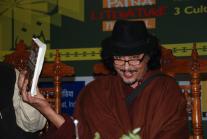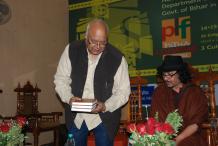Contribute
| Lokvani Talks To Rajesh Pradhan |
03/20/2014
An Interview with Dr. Rajesh Pradhan, author of "When the Saints Go Marching In: The Curious Ambivalence of Religious Sadhus in Recent Politics in India". (Published by Orient Blackswan, India, 2013.) Tell me something about your background and growing up. I was born in Patna, India, in a traditional Hindu family where religion, religious music, and traditional culture were common features of my life. My grandfather was a big influence, who also instilled in me a love for the Urdu language. Having attended the Imperial College in London, my father pushed me and my two brothers and our sister to go to good missionary schools, after which I joined the School of Planning and Architecture in New Delhi. On my mother’s insistence, I applied to and entered the Massachusetts Institute of Technology (MIT) in Cambridge in 1983. After completing a Dual Master’s degree in Architecture Studies and City Planning, I worked at the Harvard Institute for International Development, only to join MIT once again in the Ph.D. program in Political Science. It is here that I wrote my dissertation on the political activism of sadhus in India. I was awarded a post-doctoral fellowship in the Center for the Study of World Religions at Harvard. I also continued to pursue my interest in urban development, and after a short stint at the Lincoln Institute of Land Policy (and a few architectural and urban planning projects in India), I worked at the Asian Development Bank (ADB) in Manila, Philippines, on urban issues. Currently, I am a consultant with the ADB on urban development, urban poverty, and climate change. In late 2013, Orient Blackswan in India published my book on sadhus. My wife, Geeta Pradhan, works at the Boston Foundation. We have two sons, a lawyer in San Francisco, and a professional musician/saxophone player in New York. Turning to your book: tell me something about your research methods and questions, how many sadhus did you meet, how did you choose them, and where did you travel in India? I conducted my first set of about 30 interviews with sadhus soon after 1992 when the disputed Babri mosque was demolished. Politically, that event was perhaps the most significant incident since India’s Independence in 1947. A relatively obscure political party (the Bhartiya Janata Party or BJP) emerged to challenge about four-decades of monopoly of the Congress party. Sadhus were at the center of these unprecedented events. Most of my travels were in the north, since the disputed Babri mosque/Ram temple were located in Ayodhya. I followed the itinerant sadhus in Mathura, Vrindavan, Ayodhya, Allahabad, Lucknow, Gorakhpur, Haridwar, Rishikesh, Jaipur, Delhi, Patna, Gaya, Bodh Gaya, and in Shingeri near Mangalore (where I interviewed all the Shankaracharyas) Several years later I interviewed a smaller group of 10 sadhus from the original 30, during a relatively calmer period to understand the splintering of and disunity among sadhus. What led to the collective action of sadhus during one period and the splintering of that unity when sadhus were all poised to call the political shots? My first set of interviews included the movers and shakers among sadhus who had spearheaded the Ramjanmabhoomi campaign. This included the main pro-Hindutva sadhu, the late Swami Ramchandra Paramhans, who had precipitated the whole movement by sneaking the idol of Ram in the disputed Babri Masjid/Ramjanmabhoomi complex in the middle of night in December 1949. I talked at length to two of the most strident pro-Hindutva figures, the women sadhavis Uma Bharati and Rithambara. But I also met the dissenters (like the Shankarachrya Swaroopanand Saraswati), who supported the Congress’ approach of solving the Ramjanmabhoomi conflict with the participation of Muslim leaders, including social activists or non-aligned sadhus (like Swami Agnivesh). I met few moderately pro-Hindutva ones who were becoming increasingly politicized, and also spoke to a few completely apolitical and mystically oriented sadhus. To close the circle, I interviewed the stridently anti-Hindutva sadhu Baba Lal Das, who was the head priest of the Ramjanmabhoomi temple, the epicentre of the conflict. He was murdered in 1993. Through interviews, I tried to understand sadhus on several axes: why they became sadhus; how they reconciled renunciation with active engagement in the social/political arena; the nature of political activism; party affiliation; secularism and minority rights; the rise of religion as a political force; and the role of sadhus in politics. And through the perspectives of the sadhus interviewed, I showed both the deeply held passions that galvanized sadhus into action for the rise of Hindu fundamentalism, as well as the factors—‘outside’, ‘among’ and ‘within’ sadhus that subsequently contributed to their splintering. Was it easy to approach sadhus? How did you connect to them? Can you share a couple of anecdotes? It was very easy to meet and talk to them. Most sadhus come from very humble economic and social backgrounds (except the one at the Allahabad ardh-Kumbha mela, who wanted me to get a sleeping bag for him from America). When I met the imposing Shankarachrya Swaroopananda Saraswati, then head of two Shaiva centers or peeths, I started speaking the most Sanskritized Hindi I could come up with, only to realize that he was speaking the most pedestrian Hindi spoken in Bihar and U.P. Meeting one of the “junior†sadhus during that occasion in Shingeri was particularly easy. He had donned the highly revered garb of sadhu; but could not hide his inclusive nature as he later turned out to be a journalist based in Bhopal. And when I met the most important sadhu in the Ayodhya campaign, Swami Ramchandra Paramhans, it did not take him long before he started calling me “yaarâ€. That helped. The sadhavi Uma Bharati was difficult to meet because she was a Minister in the BJP government—but I had my contacts also. Yet she offered to arrange a meeting with the main political leader of BJP L. K. Advani, because she felt Advaniji was the “real†sadhu and would me readily. I met him also and included my conversation with him as part of one of the several contradictory images of a sadhu I encountered. What makes one a Sadhu? How do you define this term in your book? Are they any woman Sadhus you met and are they also politically involved? At the very least, a sadhu must be ritually and formally initiated in a sadhu sampradaya (community). But I do not even try to define the term sadhu, although I am perfectly aware of how people have tried to do that. Essentially they have taken three approaches. The first one is to break down the word “sadhu†in an etymological way (saadh, sidhhi, etc) and infer meanings from that exercise. In that sense, sadhu is one who goes straight for some transcendent goal in the most efficient way, renouncing everything that might come in the way. The historical approach looks for actual sadhu movements—like the Sant movement in northern India that started around the 13th century. It then takes the movement’s defining characteristics (inward devotion and egalitarianism as in the Sant movement) as what sadhus are eseentially or ideally made up of. A third approach emphasizes a particularly unique attitude sadhus may have toward the world (Maya or illusion, object of non-engagement or renunciation, etc.). All these approaches have flaws and limitations. Instead of trying to sort the definitional problem in an analytical way, I present in my book about 12 images of a sadhu found in the literature and folklore. These are, for instance: Sadhu as a ‘simple’ man; Sadhu as a ‘con-man’; Sadhus as an anti-householder; Sadhus as divinely mad; Sadhu as a renouncer vs. the transcendent; Sadhu as a civilised ascetic; Sadhu as a barbaric ascetic; Sadhu as a miracle worker; Sadhu as a religious scholar; Sadhu as a warrior ascetic; Sadhu as a pacifist yogi; and Sadhu as a transparent, religious,.and committed politician/leader. Did you find them caring for social causes ? The ‘social’ and the ‘political’ roles have often merged in history. Swami Sahajanand Saraswati (born 1889), for instance, championed the cause of farmers in Bihar, as did Swami Vievkanand through his Ramkrishna Mission that he founded in 1897. But none of the sadhus I met were socially active at those levels, except Mahant Avaidyanath (a Member of Parliament as well) whose ashram was extremely well endowed, allowing him to provide even hospital-like services for the poor (he also rented his ashram land to shopkeepers selling religious paraphenelia). But most sadhus any I met did provide a limited amount of free food, temporary lodging, and basic medical services to the poor. How did you arrive at your book title? The first part of the tile—“When the Saints Go Marching Inâ€â€”is a very old Americal gospel hymn, particularly popular with jazz musicians and associated specially with New Orleans. The singer Louis Armstrong popularized it during the 1930’s. The second part of the title—The Curious Ambilance of Religious Sadhus in Recent Politics in India—refers to the very argument and significance of the book. Having helped bring BJP in power, sadhus’ collective action splintered and they suddenly disappeared from the political landscape. This stands in contrast to religious elites in a few other countries who consolidated their political power once having achieved it, accidentally or through design. What is the political significance of sadhus? In my book I have equated the role of sadhus with the imagery of the serpent which lies at the base of the spine (as in Kundalini Yoga). Given certain conditions, the serpent rises, strikes in a very potent way, but then recoils. Sadhu’s political activism is therefore very lethal, but temporary or ephemeral. Sadhu-led political movement can take the form of religious nationalism and religious fundamentalism—as it did during the Ayodhya campaign, raising BJP’s parliamentary from 2 to 87 in an unprecedented short time—but it will essentially be short-lived. In comparative terms, sadhus will not occupy or hold on to the seats of power as religious elites have done in other countries. Sadhus’ political activism will be short-lived because the institution of sadhuism is based on the values of individualism and freedom that sadhus cherish the most. Because of the primacy of freedom over all other values, sadhus will fail to make any long-term political commitments and their unity and their political significance will therefore splinter.
You may also access this article through our web-site http://www.lokvani.com/

